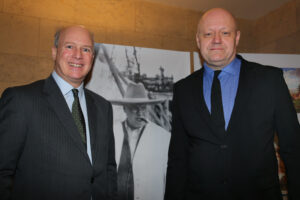
Bulletin #201 — Feb 2025
This Seat of Mars

To view in full, right click and choose "View in New Tab."
February 1, 2025
Henrietta Spencer-Churchill, Blenheim: 300 Years of Life in a Palace, Rizzoli, 2024, 360 pages, $75 / £57.50. ISBN 978–0847833504
Review by ARNI SIGURDSSON
Winston Churchill famously quipped that “at Blenheim, I took two important decisions: to be born and to marry. I have never regretted either.” His wry remark testifies to the towering role of Blenheim Palace in his life and in British history. Though famed as the ancestral seat of the dukes of Marlborough, Blenheim was far more for Churchill than merely a stately home; it was a cradle of destiny that shaped the imagination and leadership philosophy of a man who became one of the twentieth century’s most celebrated statesmen.
In Blenheim: 300 Years of Life in a Palace, Lady Henrietta Spencer-Churchill—daughter of the 11th Duke of Marlborough and sister to the current Duke—delivers a sumptuous and deeply researched account of her family’s storied estate. Blenheim is the only non-royal residence in the United Kingdom formally designated as a “palace,” a distinction owing to its extraordinary origins. After John Churchill, the first Duke of Marlborough, secured a resounding victory at the Battle of Blenheim in 1704, Queen Anne awarded him the right to build a palace on the land on which Blenheim now stands. Architects Sir John Vanbrugh and Nicholas Hawksmoor realized Marlborough’s military and political brilliance in a Baroque masterpiece that still captivates visitors centuries later.
But the palace’s resonance with Winston Churchill extended far beyond its breathtaking façade. He drew inspiration from his ancestor’s bold strategic mind, eventually encapsulating it in his monumental four-volume biography Marlborough: His Life and Times. As a result, when Churchill became Prime Minister in 1940, no one was better prepared to galvanize the nation’s resolve and orchestrate a far-reaching strategy than the man who had so thoroughly studied the tactics and character of John Churchill.

2025 International Churchill Conference
Beyond its remarkable architecture, Blenheim also owes a significant part of its splendor to the legendary landscape architect Lancelot “Capability” Brown. Renowned for his ability to “see” the potential in any terrain, Brown was commissioned in the 1760s to reshape Blenheim’s grounds into the sweeping parkland that endures to this day. Characterized by gracefully rolling lawns, artfully placed waterways, and clusters of mature trees, Brown’s designs complemented Vanbrugh’s Baroque vision while creating a more natural, harmonious setting.
Winston Churchill was born at Blenheim on November 30, 1874—unexpectedly early, as family lore has it—while his paternal grandparents were the seventh Duke and Duchess of Marlborough. This twist of fate forever intertwined him with the palace. Growing up hearing tales of his illustrious forebear, Churchill internalized Blenheim’s legacy of triumph, ambition, and resilience. The meticulously crafted vistas formed the backdrop of many of his formative experiences, reinforcing his sense of grandeur, beauty, and strategic thinking.
Churchill returned to Blenheim again and again to visit his grandparents, then his uncle the eighth duke, and his cousin “Sunny,” the ninth duke, with whom he would annually train on the palace grounds with the Oxfordshire Yeomanry. Most famously, Churchill proposed to Clementine Hozier in 1908 at the Temple of Diana, in Blenheim’s expansive grounds—a moment he often recalled as a personal victory on par with any political achievement.
This beautiful book masterfully chronicles three centuries of Blenheim’s evolution—from the vision of Vanbrugh and Hawksmoor to the sweeping parkland shaped by Brown, and finally to the modern-day custodians who protect the estate’s UNESCO World Heritage status. Lady Henrietta weaves together family lore and rigorous scholarship, casting a spotlight on storied figures like the formidable Sarah Churchill, wife of the first duke, while also delving into the architectural and landscape choices that have made Blenheim a living testament to Britain’s cultural heritage.
Hugo Rittson-Thomas’s photographs imbue each page with life and color, capturing not only the palace’s grandeur but also the nuances of the surrounding green expanses. For readers new to Blenheim, the images are a revelation; for seasoned visitors, they are a memory-laden invitation to return. Having traversed these palatial halls and grounds with fellow Icelandic Churchillians, I have experienced firsthand the gravitational pull of Blenheim. No matter how many times one visits, there is always a fresh angle—a forgotten painting, a hidden archway, a tapestry that evokes a moment in British history, or a new vantage point in the landscaped gardens. One can practically hear the echoes of Winston Churchill’s footsteps and the whispers of his ancestral legacy.
Some may find the detail exhaustive—but for admirers of Winston Churchill, British history, Baroque architecture, or the artistry of Capability Brown, such comprehensiveness is precisely the book’s greatest strength. No stone (or marble column) is left unturned, offering a panorama that satisfies both casual readers and fervent scholars. For members of the International Churchill Society, history buffs, and anyone enthralled by the confluence of place, legacy, and personal destiny, Blenheim is an indispensable read. In capturing the essence of what shaped Winston Churchill from cradle to premiership, Lady Henrietta has crafted not just a history of a palace but a meditation on how grand ideas, once nurtured, can echo across centuries.
Arni Sigurdsson is the founding chairman of the Churchill Club of Iceland.
Subscribe
WANT MORE?
Get the Churchill Bulletin delivered to your inbox once a month.





